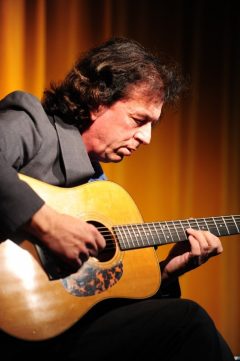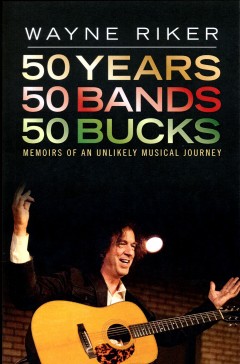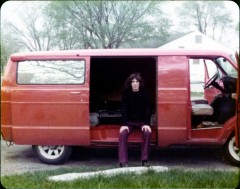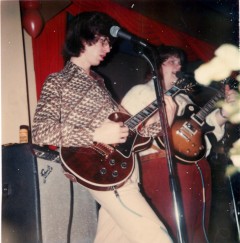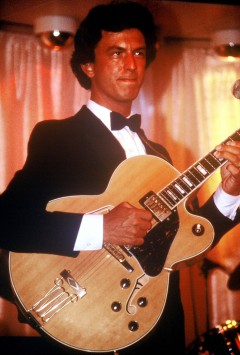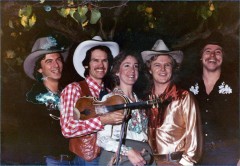Yesterday And Today
WAYNE RIKER: A Life in Music
Wayne Riker? A national treasure. A humble, but virtuoso guitarist with a dry wit, Riker has led a multifaceted life in music. An East Coast native, he was already a veteran of more than a dozen bands when he arrived in San Diego circa 1980, immediately immersing himself in the local music community.
Of course he did much more than just play gigs since his arrival 36 years ago. He recorded nine CDs in various genres. He taught and mentored generations of guitarists, wrote acclaimed music instruction books for Alfred Publishing with worldwide distribution, and also authored columns for such prestigious national publications as Acoustic Musician and Guitar Player.
But his first love is live performance, which bring us to Riker’s new book, 50 Years, 50 Bands, 50 Bucks. It’s all right there in the title: playing for 50 years in more than 50 bands and averaging 50 dollars a gig. These aren’t memoirs in a traditional sense; you’ll find only passing references to Riker’s personal life, his recordings, his other books, or his teaching. What you do get is a fascinating inside look at the music business – from the indignities of the lows to the regular paychecks of the highs.
It’s a quick, fun read as you follow Riker’s career in chronological order, wrapping up with an epilogue that is perhaps the most important part in the book. With decades in the trenches, Riker is a wise man when it comes to the business of music, offering a concise list of things that will help your music career. No glitz or glamour, just simple reality, with numerous examples of the list in use throughout the book itself.
50 Years, 50 Bands, 50 Bucks
As unlikely as it seems, the idea for the book came when looking back at his book keeping. “I bought a dime store ledger book back in the late 1960s to keep track of gig dates; logging where, when, and amount earned,” Riker said. “Hence, I had an accurate record of every gig ever played right up to the present.” A few years back he realized that his unlikely musical journey would make an interesting read as an antithesis to the myriad biographies full of “sex, drugs, and rock ‘n’ roll.” “These memoirs detail the musical challenges of working professionally in just about every musical trench in the business, wearing every hat from a yarmulke to a cowboy hat, keeping my nose clean and doing everything right from a business perspective. Many guitarists are a one-trick pony, so being a versatile player I was able to land band employment over others akin to being fluent in many languages.”
With all the basic info on hand, it was just a matter of filling in the blanks with anecdotes and memories. “Fortunately, the journal book tracked all the dates and locations of all gigs played so it was easy to recall the stories behind many of each band’s gigs in a chronological order.” Having a pretty good photographic memory, Riker was able to recall relatively easily the details of the more notable trials and tribulations he experienced from band to band. “The whole text was written and organized in about a year’s time.”
He notes that new revelations and info emerged as he sifted through the ledger. “As I revisited many of the notable gigs, I began to recall certain details, some a week or two later that I realized I had left out. Sometimes a domino effect of one memory leading to another interrelated one.”
Were there any anecdotes/stories that were too wild or unprintable? “Yes, a few,” he smiled. He points out that while there are adventures in the book, its focus is not on the salacious. “There are numerous bios, albeit interesting, about groupies, drug abuse, rehab, fame and fortune, world tours, massive egos, dysfunctional, and personalities, whereas my memoirs chronicle the everyday realities facing the working club musician, enduring the many grueling realities: low pay, not getting paid, being fired, loading, unloading, double parking, drunks, heckling, playing behind chicken wire, empty clubs, long drives, long hours, unscrupulous agents, stage tension, and endless volume complaints..”
Of the 50 combos included, he considers a few to have been standouts. “In all instances it’s bands where I got the most room to stretch out musically,” Riker said. “The Heartland Band (Band 7) was special. In addition to a strong Top 40 set list, we had three knockout floor shows including an R-rated version of the Wizard of Oz.” He also cites Twin Guitar Special (Band 12), “a two-guitar duo with drum machine, we had a diverse 300-song repertoire of everything from bluegrass to disco” and Timepiece (Band 22), “a hard-driving funk band where I got to play at volume ‘11.’” Other favorites include Stone’s Throw (Band 23), “a high visibility San Diego group with dazzling three-part harmony and a creative repertoire of diverse covers and originals” and the Shelle Blue Band (Band 43), “a strong aggregation of San Diego Rhythm & Blues musicians with lots of room for long solos on most tunes.”
Doppelgangers and Gamblers
One particularly interesting part of the book is the time he spent touring the U.S. as part of an “imposter” mid-seventies era versions of hitmakers Crazy Elephant (garage rocker “Gimme Gimme Good Loving,” #12/1969) and Peppermint Rainbow (Sunshine pop “Will You Be Staying After Sunday,” #32/1969). Though the touring lineup contained no original members, Riker didn’t mind hitting the road this way. “No problem at all as its common practice in the business,” he said. “And you receive immediate recognition from a built-in audience that knows the group’s material, particularly their one-hit wonder.” This sort of situation with imposter groups was indeed common during the pre-Internet days, with alternate versions of Fleetwood Mac and the Zombies among the groups who were impersonated. Riker explains how this sort of thing comes to be. “Since both bands were a collection of studio musicians and not a contained band, a touring band is formed to represent many of these one-hit wonder groups,” Riker said. “An agent will get the rights to the band name and then round up individual musicians or a contained group as a touring band. Even though there may be no original members, it still was a blast to have instant recognition and credibility at your shows.”
Did anyone ever question the line ups? “Oh sure, many would want to know how many original members were in the band. But for most it didn’t matter as long as you played each group’s hit songs. I remember we crossed paths with Herman’s Hermits on the road, which turned out to be five guys from Wisconsin at the time… hilarious!” he laughed.
The groups did play more than just the hit, but just barely. “With both groups we’d learn around a half dozen of their tunes. The rest of the night would be playing standard covers, although we’d generally repeat each group’s one signature hit a few times a night.” In the early seventies “standard covers” included Top 40 funk hits, making the juxtaposition of Peppermint Rainbow’s harmony-driven pop in a dance set an interesting proposition. “In this case, we would play their couple of hits straight up in between the popular funk material in our regular dance sets. Since they were slow tempo hit tunes, they served as innocuous filler in between the feverish disco and funk standards people would want to hear. Since we were playing mainly dance rooms and not concert settings and since Peppermint Rainbow was far more obscure than Crazy Elephant, the group name was just another pretty name amid the heyday of urban dance venues,” Riker remarked.
“One funny anecdote. In 1974, our agent for Peppermint Rainbow made a video demo tape instead of the usual audio demo tape. We thought it was way overkill at the time. Looking back, he was way ahead of the times.”
Longtime San Diegan’s will be drawn to the chapter about Riker’s time with Roberta Linn and the Gamblers who were the house act at the Atlantis Restaurant near Sea World. Linn had Rat Pack lineage, a friend of Sinatra’s who sang at his Cal Nevada Lodge, something often mentioned onstage. “Oh my, yes, she was the biggest name dropper in the world,” Riker stated good naturedly. “Much of her schtick was spouting her entire career history to her nightly audience while the band would be playing a four-chord vamp behind her. We’d be falling asleep as her ballad tune intros would linger for usually 15 minutes while she would narrate in exhausting detail her days as the original Champagne Lady with Lawrence Welk, preceeded by her 11 years as a headliner in Las Vegas with her then husband Freddy Bell, and, yes, mentioning the Rat Pack and many other notables along the way. That being said, she had that cred and could back it up with her career experiences and stature.” Her long music history meant that many well-known friends would often show up in her audiences. “She was good friends with many of the local luminaries here; several notables who would attend her shows included Kingston Trio members, Jesse Davis, the Cascades, tap dancer Arthur Duncan, and others that escape my memory, but she was very popular here as she had the house gig at the Atlantis Restaurant for over six years, five nights a week.”
To order the book, go to: amazon.com
Music Instruction
Looking back on your decades in music what are you proudest of? Is there anything you might have done differently? “By far, I’m proudest of my guitar teaching career, which ran concurrently during my performing career,” Riker said. “There is nothing more satisfying than knowing you lit candles for and inspired a few generations of guitarists, both hobbyists and budding professionals, along the way. As far as teaching stories, well, there may be a second book after all,” he said.
Among the musicians he has worked with over his 43 year teaching career include Calman Hart, Deborah Liv Johnson, Simon Kafka (now with Elle King), Jonathan Barker, Todd Pyke, Tommy Collins, Joseph Lorge (Wrong Trousers), Joe Rathburn, A.J. Croce, Sandra Velasquez, Zori Tinker, Matt Heinecke to name a few. “It’s always great hearing from former students through the magic of social media,” he said. One mentored musician turns up as band 48, the Steph Johnson Group. “Steph has exceeded everyone’s expectations, she’s going about it the right way–with passion, dedication, and the right social skills and business and promotional acumen,” he enthused. “I am proud of her progress as I was her first mentor in her musical journey.”
“As for as doing things differently, perhaps if I had stuck to one style I may have garnered more recognition in one particular genre. By spreading myself thin in the ability to play almost every style proficiently, you never get fully recognized in any one musical category. Overall, though, I still find contentment in playing in all the musical trenches, which is really the main theme of the memoirs.”
Despite a lengthy career as a sideman, interestingly, he avoided being a session player. “I’ve generally avoided it because working on other’s projects is never quite the same as your own,” he said. “However, I did a number of sessions at Howard Peterson’s house on Golfcrest Drive in San Diego back in the 1980s. He was the keyboardist in Tuxedo and did a lot of library music and jingles there; he had a high-quality recording setup for the times. Many high-caliber local players were regulars there.”
Of his nine CDs, seven are original instrumentals with full groups and solo. “I was inspired by a fellow Guitar Institute of Technology classmate Scott Henderson, who, during one of his guitar clinics in the late 1990s, mentioned his formula for composing instrumental tunes by establishing a melody first, then experimenting with different random chord options below each note, one by one. That became my formula for almost every tune I wrote.”
Modern Times
These days Riker is retired from the music biz, but he’s willing to make one occasional exception: playing live. “I’m relaxing, enjoying being somewhat financially stable with the long-awaited perks of Social Security and Medicare benefits that come with now being an official senior citizen at 65,” he laughed. “I’m done with new music after nine CDs. I’ve reached all my musical goals, bucket list complete, now on to a new career adventure–why not? Although, yes, if a few propitious live dates come along, I will play some solo shows; it’s nice to now have the freedom to pick and choose and not have to race out to some miserable gig to make funds to pay the electric bill,” he said.
No doubt about it, Wayne Riker has had an amazing life in music. Is something like this even possible today? “Yes, if you learn as many styles as you can, have strong character and public relation skills, and understand that music is a business,” he said. “It’s not easy, but if you adhere to basic common-sense life principles, you can be successful. For example, don’t be late for anything, respect the music you’re playing, be prepared in whatever you have to learn, have good-sounding and working equipment, show respect for fellow musicians, and leave your ego at the door. Most musicians falter in some or all of these aspects, so your competition becomes minimal.”
Does you still enjoy music as much today as you did when you started out?
“Equally, both performing and teaching,” Riker said. “But it doesn’t consume nearly as many hours of the day as it used to. The older you get, the more you want to spend time enjoying other facets of life,” he mused.
Wayne Rikers Top Ten Albums:
Essential listening , in no particular order:
Child Is Father to the Man: Blood Sweat & Tears
Axis Bold as Love: Jimi Hendrix
The White Album: The Beatles
The Jerry Hahn Brotherhood: self titled
Inner Mounting Flame: Mahavishnu Orchestra
Fumbling Towards Ecstasy: Sarah McLachlan
Unfinished Business: Danny Gatton
Blues and the Abstract Truth: Oliver Nelson
Live at the Regal: B.B. King
Cookbook: George Benson






